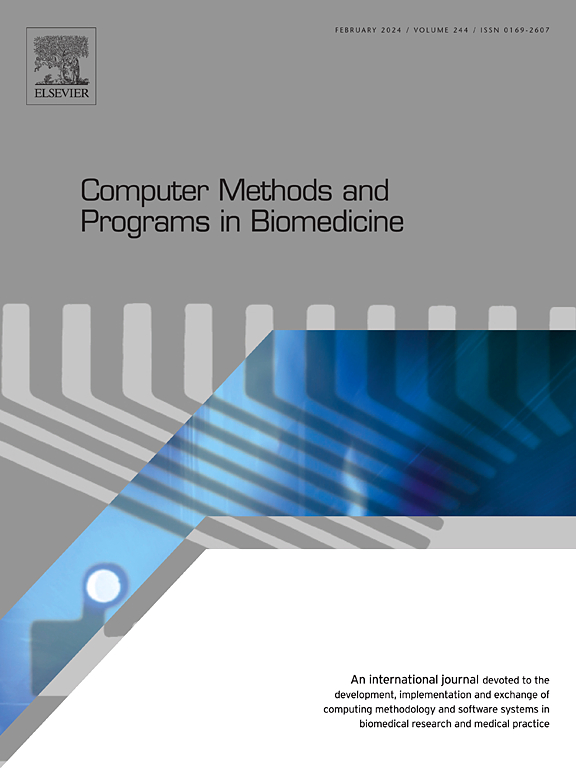Malignant melanoma fractional-order mathematical model with stabilized fuzzy sliding mode control
IF 4.9
2区 医学
Q1 COMPUTER SCIENCE, INTERDISCIPLINARY APPLICATIONS
引用次数: 0
Abstract
Background and Objective:
Malignant melanoma, an aggressive form of skin cancer, poses significant challenges due to its rapid progression, metastatic potential, and resistance to therapies. This study aims to develop a fractional-order mathematical model capturing melanoma dynamics (tumor-immune interactions, extracellular matrix remodeling, nutrient dynamics) and introduce a Stabilized Fuzzy Sliding Mode Control (SFSMC) strategy to suppress tumor growth and restore microenvironmental homeostasis.
Methods:
A fractional-order model was derived using Caputo derivatives to incorporate memory effects and long-range dependencies. The SFSMC combines sliding mode control with fuzzy logic to manage uncertainties. Theoretical analysis included well-posedness, stability (via Lyapunov functions), and computation of the reproduction number . Numerical simulations were performed using a predictor–corrector method with parameters calibrated from clinical data.
Results:
The model demonstrated stability when , indicating tumor suppression. SFSMC reduced tumor cell populations by 78% and circulating tumor cells by 65% while improving immune response (45% increase in immune cells) and nutrient availability (30% recovery). Sensitivity analysis revealed is mostly influenced by tumor growth rate, natural degradation rate of extracellular matrix (ECM), rate of ECM degradation by tumor cells, and ECM production rate, suggesting their potential role in suppressing tumor growth.
Conclusions:
The fractional-order framework and SFSMC offer a robust approach to modeling and controlling melanoma, with potential clinical implications for adaptive therapy.
具有稳定模糊滑模控制的恶性黑色素瘤分数阶数学模型
背景与目的:恶性黑色素瘤是一种侵袭性皮肤癌,由于其快速进展、转移潜力和对治疗的耐药性,给治疗带来了重大挑战。本研究旨在建立一个分数阶数学模型,捕捉黑色素瘤动力学(肿瘤-免疫相互作用、细胞外基质重塑、营养动力学),并引入稳定模糊滑模控制(SFSMC)策略来抑制肿瘤生长和恢复微环境稳态。方法:利用卡普托导数建立分数阶模型,考虑记忆效应和长期依赖关系。SFSMC将滑模控制与模糊逻辑相结合来管理不确定性。理论分析包括适定性、稳定性(通过Lyapunov函数)和再现数R0的计算。数值模拟采用预测校正方法,根据临床数据校准参数。结果:模型在R0<;1时稳定,表明肿瘤抑制。SFSMC减少了78%的肿瘤细胞群,减少了65%的循环肿瘤细胞,同时改善了免疫反应(增加了45%的免疫细胞)和营养利用率(恢复了30%)。敏感性分析显示,R0主要受肿瘤生长速率、细胞外基质(ECM)自然降解速率、肿瘤细胞对ECM的降解速率和ECM生成速率的影响,提示其可能具有抑制肿瘤生长的作用。结论:分数阶框架和SFSMC为黑色素瘤的建模和控制提供了一种强大的方法,对适应性治疗具有潜在的临床意义。
本文章由计算机程序翻译,如有差异,请以英文原文为准。
求助全文
约1分钟内获得全文
求助全文
来源期刊

Computer methods and programs in biomedicine
工程技术-工程:生物医学
CiteScore
12.30
自引率
6.60%
发文量
601
审稿时长
135 days
期刊介绍:
To encourage the development of formal computing methods, and their application in biomedical research and medical practice, by illustration of fundamental principles in biomedical informatics research; to stimulate basic research into application software design; to report the state of research of biomedical information processing projects; to report new computer methodologies applied in biomedical areas; the eventual distribution of demonstrable software to avoid duplication of effort; to provide a forum for discussion and improvement of existing software; to optimize contact between national organizations and regional user groups by promoting an international exchange of information on formal methods, standards and software in biomedicine.
Computer Methods and Programs in Biomedicine covers computing methodology and software systems derived from computing science for implementation in all aspects of biomedical research and medical practice. It is designed to serve: biochemists; biologists; geneticists; immunologists; neuroscientists; pharmacologists; toxicologists; clinicians; epidemiologists; psychiatrists; psychologists; cardiologists; chemists; (radio)physicists; computer scientists; programmers and systems analysts; biomedical, clinical, electrical and other engineers; teachers of medical informatics and users of educational software.
 求助内容:
求助内容: 应助结果提醒方式:
应助结果提醒方式:


